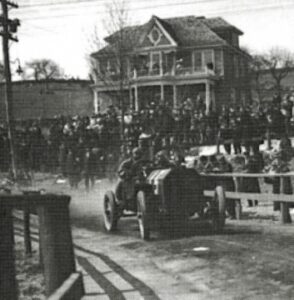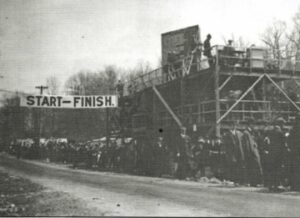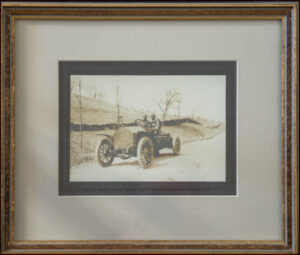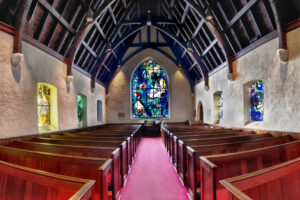
At 5:07 a.m. on April 24, 1908, 22 drivers set out on the first Briarcliff Road Race, a 256-mile contest that captured the nation’s attention and jump-started the automobile’s popularity.
The race, sponsored by Briarcliff Manor village founder Walter Law, was in the headlines before it even started.
The front page of The New York Times’ that Friday morning reported that last-minute wrangling over insurance and other issues had been settled and 1,000 militiamen were being rushed by train to guard the course. The Times estimated some 10,000 vehicles would line the roads, with tens of thousands of spectators arriving by train and trolley.
The landmark event, held when the automobile industry was seeking to establish its vehicles as more than simply novelties for the wealthy, is the subject of a May 21 presentation by the Briarcliff Manor-Scarborough Historical Society.
The Historical Society has framed photographs of 11 of the original drivers as well as the souvenir program from the race’s centennial celebration in October 2008. The photos show the drivers accompanied by a passenger, presumably for navigation or mechanical help.
During the program at the William J. Vescio Community Center, Historical Society volunteer Howard Dale will give a talk and a PowerPoint presentation about the race.
The race drew an overflow crowd to a village that had only 930 residents in 1908.
“Around the entire course, something like 300,000 came to see that race and apparently there were 100,000 people in Briarcliff Manor who came to see it,” Dale said.
“The other thing that I didn’t realize was this coincidence of needs between the car industry and Walter Law’s need to try and develop Briarcliff Manor,” Dale added.

The race featured models manufactured by 14 car makers from around the world including Bianchi, Fiat, Isotta Fraschini (Italian); Renault (French); Benz (German); and Stearns, Lozier, Simplex, Thomas, Allen-Kingston, Apperson and Hol-Tan (American).
Drivers competed for $10,000 and a huge silver trophy, both donated by Law, a wealthy business owner and auto enthusiast who saw the event as good publicity for the village he founded six years earlier.
One account at the time described the route as “a tortuous circuit of the crumpled-up paper type, with impossible bends and turns, each one with its pitfall of narrow, creaky bridge, or its menacing stone wall, and with scarcely a quarter mile straight, or a half-dozen places where a competitor could be passed safely at speed.”
The automobiles left the starting line, about 100 feet south of the traffic light at Pleasantville and North State roads, at one-minute intervals.
The eight-lap contest headed north to Merritt’s Corners (now Millwood) and north to Pinesbridge (now Yorktown), where the course traced the south shore of the New Croton Reservoir. Next came Mount Kisco, where a motorcycle escort led drivers through a 20-mph zone.
Crossing Routes 117 and 128 in what was then Newcastle Corners, a 4-mile straightaway let the racers reach their top speed of 75 mph. Drivers then whizzed past the Kensico Dam on Route 22.
In Eastview, the race’s only serious crash occurred during the first lap, when R.C. Watson’s Simplex struck a telephone pole and flipped over, bending the steering column. Watson, who was not injured, twisted the column into place and was able to complete five laps.

The last leg of the race traversed country roads through what is now the Saw Mill River Parkway-Route 9A corridor.
At 11:40 a.m. an Isotta-Fraschini driven by Louis Strang was first across the finish line, completing the race in 5 hours, 14 minutes and 13.5 seconds at an average speed of 45.22 mph. Strang, who went to school in Scarborough, trained for five weeks in preparation for the race, and felt his knowledge of the roads contributed to his victory.
Three years later, Strang was killed in a car crash, two months after competing in the inaugural running of the Indianapolis 500
Eighteen of the 22 cars finished the Briarcliff Road Race. The racers’ average speed — 42.6 mph — seems slow by today’s standards, but considering many of the roads were narrow, ungraded and made of dirt and cinders, it’s remarkably fast.
If you go
- Who: Briarcliff Manor-Scarborough Historical Society
- What: Presentation about the 1908 Briarcliff Road Race. Refreshments to follow.
- When: 2 p.m. Sunday, May 21
- Where: William J. Vescio Community Center, Library Road, Briarcliff Manor
- Information: Admission is free. Visit facebook.com/BriarcliffHistory or call 914-941-4393







Rob, Interesting history, especially for us auto aficionados! Thanks! Ken